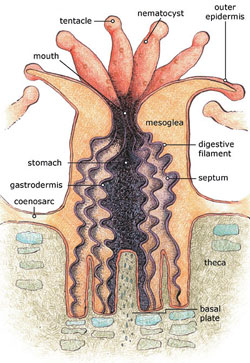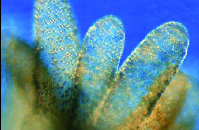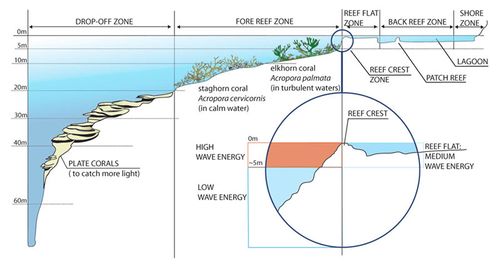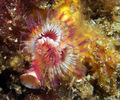Coral reefs
This article describes the habitat and functions of coral reefs. It is one of the sub-categories within the section dealing with biodiversity of marine habitats and ecosystems.
Contents
Introduction
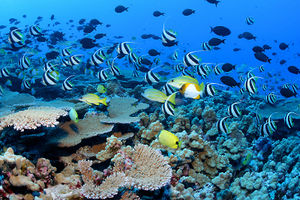
Coral reefs are among the most diverse ecosystems in the world. Corals belong to the Phylum Cnidaria. The best-known type of corals is the one living in clear, warm tropical waters with plenty of colorful fishes (Fig.1). This is a rocky, shallow water type. The water is clear because of the low concentrations of nutrients. But there are also deep water corals that live in dark cold waters and soft corals that live in shallow, cold waters. Corals are wave resistant rock structures, created by calcium carbonate secreting animals and plants.
Formation (warm water corals)
The formation of corals begins when free-swimming coral larvae attach to submerged rocks or other hard substrate along the edges of islands or continents. The reef expands and will form an atoll, barrier or fringing reef. These 3 are the main reef types. Atolls are circular or oval coral reefs (Fig. 2a) that partially or completely encircle a lagoon. A barrier reef (Fig. 2b) is a reef that borders the shoreline over a long distance. They are separated from the adjacent land mass by a lagoon. A fringing reef (Fig. 2c) forms borders along the shoreline and the surrounding islands, but at shorter distance than barrier reefs. It is directly attached to the land. This is the most common type of coral reefs [2]. Other special reef arrangements are apron, patch, ribbon, table and bank reefs. Apron reefs are very similar to fringing reefs. Both are extending downward from the land margin, the former more gently sloping than the latter. Patch reefs (Fig. 2d) are small, isolated outcrops of coral surrounded by sand and/or seagrass, and may form part of a fringing reef system. Ribbon reefs (Fig. 2e) are the small and long components of a barrier or are connected to an atoll lagoon. Table reefs are future atolls, but are not yet connected to a lagoon. At last, bank reefs are similar to the patch reefs, but are larger and often hemispherical.
Coral reefs are also among the oldest habitats in the ocean. They have slow growth rates and it may take up to 10,000 years for a coral reef to fully develop from the first colonising larvae [3]. The different types all share similarities in their biogeographic profiles. Horizontal and vertical zonation depends on bottom topography, depth, wave and current strength, light, temperature and suspended sediments.
Distribution
Warm water corals (WWC)
The warm water corals are found in the tropics (between 30°N and 30°S, Fig. 3) in areas where the water is clear and over 18°C. The maximum depth for warm water corals is generally around 60 meters. Some species of coral are found in all oceans of the world.
Cold-water corals (CWC)
Globally viewed, cold-water corals cover a wide range of depths (39 - 2000 m) and latitude (70°N – 60°S, Fig. 3). They most commonly occur in continental slope settings, on deep shelves and along the flanks of oceanic banks and seamounts (Cordes et al., 2016[4]). The majority of CWC occur between the depths of 200 to 1000 m, with the bathymetric ranges becoming shallower towards the poles (Roberts et al., 2009[5]). Lophelia pertusa (Fig. 8) is the dominant reef-forming CWC in the Atlantic.
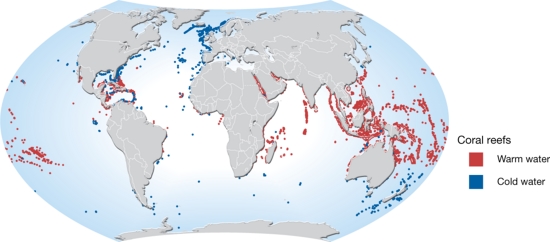
Biology
The principal reef-building organisms are hard coral (scleractinian corals). The formation starts with a larva known as planula that settles down and attaches itself to a hard substrate. Then the larva develops into a coral polyp and secretes calcium carbonate around its body. The reproduction is by budding, an asexual process. As the asexual reproduction continues, the colony grows. Some polyps in the colony develop gonads and are able to reproduce sexually. These polyps release sperm and eggs in the surrounding water. To help with fertilization, both eggs and sperm cells have protein molecules on their surfaces to identify other cells of the same species (Karleskint, 1998[7]).
The coral polyp has a sac-like structure that is protected by a rigid calcium-carbonate exoskeleton (Fig. 4). This is called a corallite. The bottom of the corallite is divided into vertical segments or septa. At the top, the polyp has an opening that is a combined mouth and anus. This leads to the gut. The opening is surrounded by tentacles with mucus secreting cells for catching prey. Zooxanthellae (Dinoflagellates) are embedded in the outer layer of the coral’s flesh (epidermis), giving the coral it's color (Fig. 5). This causes a stable environment for them. The cells are abundant and can represent up to 75% of the tissue weight. The zooxanthellae require sunlight for photosynthesis. They provide nutrients to the polyps and reduce the level of carbon dioxide. This makes the conditions for the formation of skeletons more suitable. In turn, the zooxanthellae get a suitable habitat. The coral species which harbour the zooxanthellae are called hermatypic.
Not all corals are reef building species. There are also hard corals existing as single, solitary polyps. Some temperate species form small colonies only. Corals that lack the hard outer coverings of calcium carbonate are soft corals. Cold water corals lack the symbiotic Dinoflagellates. The species without zooxanthellae is called ahermatypic.
Reef zonation (WWC)
On the seaward side, the reef rises from the lower depths of the ocean to a level just at or just below the surface of the water (Fig. 6). This is called the reef front or fore-reef. The slope of this zone varies from gentle to steep. It sometimes forms a vertical wall known as a drop-off. But generally, the reef front forms finger-like arrangements called spur and groove formations. It breaks the wave energy and prevents damage to the reef. The grooves are sand-filled pockets, which allow sediment to be channelled down and away from the coral surface and provide a habitat for many species of burrowing organisms. The reef crest is the highest point of the reef. More land inward, the reef flat or back reef is formed. This zone has a high variability. The bottom of the reef flat consists of rock, sand, coral cobble or a combination of these. Seagrasses are commonly found in this zone. The reef ends at the shoreline or descends into the lagoon.
The different levels in the zonation support different species. On the on the intermediate slopes of the reef front, dome-shaped, massive brain corals (Diploria, Fig. 7a) and columnar pillar corals (Dendrogyra, Fig. 7b) are found. Below this region, plate corals such as Pectinia, Pavona and Agaricia are found. Higher upon the reef, where wave stress is greatest, there are branched species of coral. A coral that occurs in this zone is elkhorn coral (Acropora palmata, Fig. 7c). Behind the reef front, more protected zones are occupied with more delicate species such as staghorn coral (Acropora cervicornis, Fig. 7d), finger (Stylophora), cluster (Pocillopora) and lace corals (Pocillopora damicornis). In shallow, calmer waters away from the reef front, small species such as rose (Meandrina, Manicina), flower (Mussa, Eusmilia) and star (Montastraea) corals are found. [8]
Fig. 7a. Brain coral (Diploria strigosa) [9]
Fig. 7b. Pillar coral (Dendrogyra cylindrus) [10]
Fig. 7c. Elkhorn coral (Acropora palmata)
Fig. 7d. Staghorn coral (Acropora cervicornis) Photo credit W. Jaap
Conditions for growth
Warm water corals
Reef-building, warm water corals need the following environmental conditions to grow:
- Clear water : this allows light to reach the photosynthetic zooxanthellae;
- Light-absorbing adaptations enable some species to live in dim blue light;
- Ocean temperatures of more than 18°C;
- Strong wave action which ensures: supply of food and oxygen, the distribution of larvae and prevents sediment to settle on the reefs;
- Precipitation of calcium (aragonite) necessary for the formation of skeletons. Water temperatures and salinity have to be high and carbon dioxide concentrations have to be low;
- Hard substrate.
Cold water corals
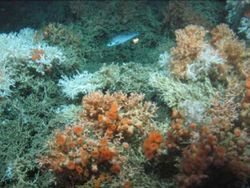
Cold water corals do not need light to function. They obtain their nutrients and energy completely from trapping plankton and organic particles in passing currents. Lophelia pertusa has been shown to incorporate everything from dissolved and particular organic carbon to algal biomass to small zooplankton. CWC include stone corals, true soft corals, black corals and lace corals. Although the majority of the species-level diversity is in the solitary corals, some of the CWC form extensive reef structures, occasionally accumulating into large carbonate mounds, or bioherms (Cordes et al., 2016[4]). All CWC are extremely fragile and vulnerable to physical disturbance. The polyps cannot escape disturbances and their structures are extremely brittle. They also grow extremely slow (there are no zooxanthellae in the dark), so it takes a long time to rebuild the reef when it is damaged. A further disadvantage is that they cannot respond to fast-occurring changes in their environment, as they are adapted to stable conditions (WWF, 2001[12]).
Cold water corals such as Lophelia pertusa (Fig. 8) are true hard corals that produce calcium carbonate skeletons. They are mainly found at depths between 200 and 1,000 meters along continental shelves, in fjords and around offshore submarine banks, vents and seamounts. Lophelia pertusa is the dominant reef-forming CWC in the Atlantic and is found at 330-470 m water depth (Hebbeln et al., 2020[13]). The suitable temperature ranges from 4°C to 13°C, but they occur in some regions at much higher temperatures (>20°C). Lophelia is not found in the polar regions. Lophelia thrives in hypoxic water (lower oxygen limit DO ~4 ml/l but in some areas ~1 ml/l) (Hebbeln et al., 2020[13]) that is saturated with aragonite. Madrepora oculata is another cold water coral species. The species is found in the north-east and western Atlantic and the Mediterranean Sea.
Coral reef ecosystem
Coral reefs provide a structured habitat with a lot of niches for many species. They support a highly diverse community, comprising faunal biomass that is orders of magnitude above that of the surrounding. They also serve as important spawning, nursery, breeding and feeding areas for a multitude of fishes and invertebrates and habitat for transient diel vertical migrators. This holds both for warm-water and cold-water reefs.
Many animals of the warm-water reefs are sessile or move very slowly. Sponges are found at deeper parts of the reef front. Smaller animals are found in the waters behind the reef. Anemones remain fixed in one place by a muscular, mucus-secreting basal disk. If the conditions become unfavorable, some sessile species can release themselves and crawl over the bottom, searching for a more suitable area. Fanworms or featherduster worms are represented by two families: the serpulid worms (Fig. 9a), which produce tubes of calcium carbonate, and sabellid worms, which form tubes of sand and small particles pasted together by mucus.
Organisms that can be found on the branches of coral reefs are: fish (Fig. 9b), crustaceans, starfish, molluscs, brittle stars (Fig. 9c), sea pens (Fig. 9d), sea urchins and squids. Sponges, bryozoans, hydroids, and some other coral species are found on the coral itself. The octopus (Fig. 9e) is one of the most formidable predators. It can rapidly change its color in response to its background (camouflage) and has very sharp eyesight. They have the ability to squeeze through small spaces where potential predators cannot gain access. Although the octopus is very well adapted to the environment, the moray eel is the dominant nocturnal predator. They live in cracks, crevices and holes. At night, they come out to feed on shrimps, crabs, octopuses and other fish. During the day, the barracuda (Fig. 9f) takes its place as the dominant predator (Karleskint, 1998[7]).
Fig. 9a. Serpulid worm (Serpula columbiana)
Fig. 9b. Moray eel
Fig. 9c. Brittle star
Fig. 9e. Common octopus (Octopus vulgaris) [14]
Fig. 9f. Barracuda (Sphyraena barracuda). Photo credit NOAA.
Coastal protection function (WWC)
Coral reefs provide important protection for coasts and coastal populations against the destructive forces of the sea under storm conditions. Coral reefs are particularly effective wave attenuators. Assessment of a large number of studies shows that a whole coral reef reduces wave height by 76–89%. The most important wave reduction (~64%) is due to the reef crest and a further ~43% reduction is achieved by the reef flat (Ferrario et al., 2014[15]). Both reef crests and reef flats dissipate disproportionately more wave energy as the incident wave energy increases. In cases where reefs have been degraded, recovery is more beneficial than technical repair with hard structures, in both environmental and cost aspects (Ferrario et al., 2014[15]). Recovery of the reef crest is most effective. However, there is not yet much experience with the design of reef restoration projects. Some success has been achieved with a technique called 'coral gardening', which consists of collecting and selecting coral seed for germination in nurseries, after which the adult corals can be reintroduced on the degraded reef (Lirman and Schopmeyer, 2016[16]). Coral gardening seems to be a more promising technique than previously experimented coral transplantation. To be effective, recovery techniques require first eliminating the original causes of reef degradation.
Threats
Natural causes are:
- Storms and tidal emersions;
- El Niño: increased sea surface temperatures, decreased sea level and increased salinity from altered rainfall;
- Predation by fishes, marine worms, barnacles, crabs, snails and sea stars;
- Dust outbreaks.
Human-induced causes are:
- Chemical pollution: see the article Threats to Coral Reefs: the Effects of Chemical Pollution.
- Eutrophication: Many eutrophicated regions which in the past were renowned for their corals are now dominated by macro algae and filamentous algae and expansion of seagrass beds (Bell, 1992[17]).
- Fishery: Coral is easily damaged by fishing gear, especially bottom trawls. Even worse are destructive fishing practices, such as cyanide and dynamite fishing, which are still prevalent in poorly regulated and enforced maritime areas in Southeast Asia.
- Dredging and dumping: Direct cutting through the reef and release of plumes of suspended sediment, which can settle on coral reefs and damage them from food and sunlight starvation.
- Coral mining: Extraction of coral for use as a building material.
Climate change
To date, the above human activities are the main cause of the widespread decline of coral reefs. An (even greater) looming threat to coral reefs is climate change, which is accompanied by increasing seawater temperature and increasing seawater acidity. A strong relationship has been observed between short periods of elevated sea temperature, mass coral bleaching and mortality within warm-water coral reefs (Hoegh-Guldberg, 1999[18]). There is also strong experimental evidence that net ecosystem calcification and net community production will be altered when concentrations of dissolved CO2 in seawater increase (Noonan et al., 2018[19]; Comeau et al., 2019[20]; Doo et al., 2019[21]). A comprehensive review leads to the conclusion that coral reefs are unlikely to be able to adapt at rates sufficient to keep up with the rapid ocean warming (0.1–0.15 oC per decade) and acidification, especially given the fact that corals are long-lived and therefore have a slow evolution (Hoegh-Guldberg et al., 2017[22]). However, there is some evidence that colonization by recruits immigrating from warmer locations can help adapt to higher temperatures, assuming slow warming and the absence of other stressors such as acidification and pollution (Matz et al., 2020[23]). Transplantation of bleaching-resistant coral species could also be an option (Barott et al., 2020[24]).
Related articles
External link
References
- ↑ http://en.wikipedia.org/wiki/Coral_reef
- ↑ NOAA National Ocean Service Education: Corals
- ↑ Barnes R.D. 1987. Invertebrate Zoology. Fifth edition. Fort Worth, TX. Harcourt Brace Jovanovich College Publishers. 92-96, 127-134, 149-162
- ↑ 4.0 4.1 Cordes, E., Arnaud-Haond, S., Bergstad, O-A., Costa Falcao, A.P., Fereiwald, A., Toberts, J.M. and Bernal, P. 2016. The First Global Integrated Marine Assessment, World Ocean Assessment, Chapter 42. Cold-Water Corals. Regular Process for Global Reporting and Assessment of the State of the Marine Environment. UN
- ↑ Roberts, J.M., Wheeler, A.J., Freiwald, A. and Cairns, S.D. 2009. Cold-water Corals: The Biology and Geology of Deep-sea Coral Habitats. Cambridge: Cambridge University Press
- ↑ UNEP/GRID-Arendal - Hugo Ahlenius
- ↑ 7.0 7.1 Karleskint G. 1998. Introduction to marine biology. Harcourt Brace College Publishers. p.378
- ↑ Karleskint G. 1998. Introduction to marine biology. Harcourt Brace College Publishers. p.378
- ↑ http://nl.wikipedia.org/wiki/Hersenkoraal - Photo credit Albert Kok
- ↑ http://en.wikipedia.org/wiki/Dendrogyra - Photo credit NOAA
- ↑ Roberts, J.M., Changing Oceans Expedition 2012, funded by UK Ocean Acidification programme (NERC, DECC, Defra)
- ↑ WWF. 2001. Cold water corals: fragile havens in the deep. p. 12
- ↑ 13.0 13.1 Hebbeln, D., Wienberg, C., Dullo, W-C., Freiwald, A., Mienis, F., Orejas, C. and Titschack, J. 2020. Cold-water coral reefs thriving under hypoxia. Coral Reefs 39: 853–859
- ↑ http://en.wikipedia.org/wiki/Octopus - Photo credit Albert Kok
- ↑ 15.0 15.1 Ferrario, F., Beck, M.W., Storlazzi, C.D., Micheli, F., Shepard, C.C, and Airoldi, L. 2014. The effectiveness of coral reefs for coastal hazard risk reduction and adaptation. Nature Communications 5: 3794 , DOI: 10.1038/ncomms4794
- ↑ Lirman, D. and Schopmeyer, S. 2016. Ecological solutions to reef degradation: optimizing coral reef restoration in the Caribbean and Western Atlantic. PeerJ, 4, e2597. https://doi.org/10.7717/peerj.2597
- ↑ Bell, P.R.F. 1992. Eutrophication and coral reefs—Some examples in the Great Barrier Reef Lagoon. Water Research 26: 553–568
- ↑ Hoegh-Guldberg, O. 1999. Coral bleaching, climate change and the future of the world’s coral reefs. Mar. Freshw. Res. 50, 839–866. doi: 10.1071/MF99078
- ↑ Noonan, S.H.C., Kluibenschedl, A. and Fabricius, K.E. 2018. Ocean acidification alters early successional coral reef communities and their rates of community metabolism. PLoS ONE 13(5): e0197130
- ↑ Comeau, S., Cornwall, C. E., DeCarlo, T. M., Doo, S. S., Carpenter R. C. and McCulloch, M. T. 2019. Resistance to ocean acidification in coral reef taxa is not gained by acclimatization. Nature Climate Change volume 9: 477–483
- ↑ Doo, S.S., Edmunds, P.J. and Carpenter, R.C. 2019. Ocean acidification effects on in situ coral reef metabolism. Nature Scientific Reports 9:12067 https://doi.org/10.1038/s41598-019-48407-7
- ↑ Hoegh-Guldberg, O., Poloczanska, E.S., Skirving, W. and Dove, S. 2017. Coral Reef Ecosystems under Climate Change and Ocean Acidification. Front. Mar. Sci. 4: 158. doi: 10.3389
- ↑ Matz, M.V., Treml, E.A. and Haller, B.C. 2020. Estimating the potential for coral adaptation to global warming across the Indo-Pacific. Glob. Change Biol. 26: 3473-3481
- ↑ Barott, K.L., Huffmyer, A.S., Davidson, J.M., Lenz, E.A., Matsuda, S.B., Hancock, J.R., Innis, T., Drury, C., Putnam, H.M. and Gates, R.D. 2020. Bleaching resistant corals retain heat tolerance following acclimatization to environmentally distinct reefs. bioRxiv preprint doi: https://doi.org/10.1101/2020.09.25.314203
Please note that others may also have edited the contents of this article.
|






